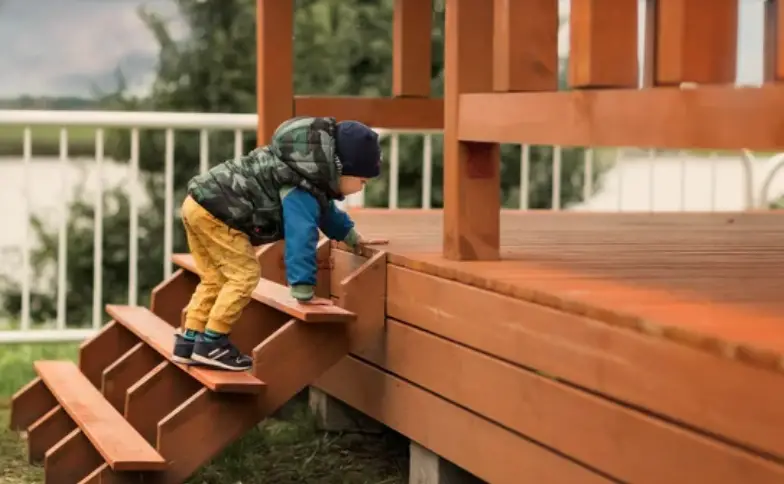Gardens are frequently viewed as calm, unspoiled refuges where we can get away from the stress of daily life. They give people a place to unwind, have fun, and think.
It’s crucial to have both useful and visually beautiful walkways if you want to fully appreciate your garden’s beauty. Wooden steps are a beautiful addition that may completely transform your yard.
Wooden stairs provide an attractive and rustic beauty to your garden while also making it feasible to access different levels. This thorough guide will cover all you need to know about garden wooden steps, from design considerations to care advice.
Also, we’ll give you a list of the items you’ll need as well as a step-by-step tutorial for creating your wooden garden stairs.
Benefits of Wooden Stairs in Your Garden
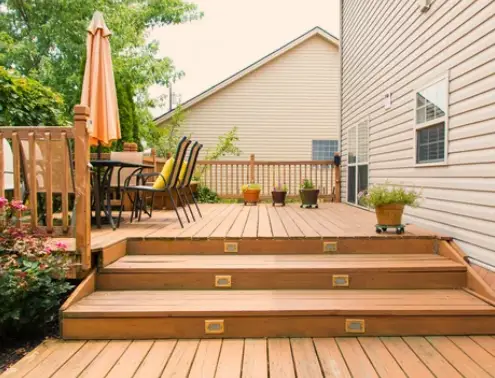
1. Enhancing Aesthetics
Wooden stairs can significantly enhance the visual appeal of your garden. They blend seamlessly with natural surroundings, creating a harmonious and rustic atmosphere. The warm tones and textures of wood provide a contrast to the greenery, making your garden more inviting and picturesque.
2 Functionality and Accessibility
One of the primary reasons for installing garden stairs is to improve accessibility.
If your garden has different levels or slopes, wooden stairs offer a safe and convenient way to navigate these areas.
Whether you’re carrying gardening tools, enjoying a leisurely stroll, or simply accessing different parts of your garden, stairs make it easier and more enjoyable.
3 Natural Appeal
Wooden stairs have a unique ability to connect your garden with nature. They complement the organic elements of your outdoor space, making it feel like an extension of your home.
Unlike metal or concrete stairs, wood feels softer underfoot, creating a more natural and comfortable walking experience.
4 Sustainability
Many people are becoming increasingly eco-conscious, and wooden stairs can align with sustainable living practices.
By choosing sustainably sourced wood, you can minimize your environmental impact. Wood is also biodegradable, making it a responsible choice for garden construction.
Design Considerations
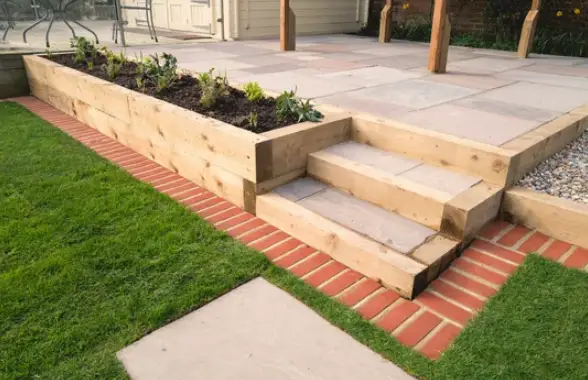
wooden stairs for garden
1 Choosing the Right Wood
Selecting the appropriate wood for your garden stairs is crucial for their longevity and appearance.
Cedar, redwood, and pressure-treated pine are popular choices due to their natural resistance to decay and insects. Consider the wood’s color, grain pattern, and durability when making your selection.
2 Design Style
The design of your wooden stairs should complement the overall aesthetics of your garden. Whether you prefer a classic, rustic, or contemporary style, your stairs should seamlessly integrate into the landscape. You can choose from straight, curved, or spiral designs to match your garden’s layout.
3 Dimensions and Layout
Careful planning of dimensions and layout is essential to ensure that your stairs are both functional and safe. Measure the height and slope of the terrain to determine the number of steps needed. Additionally, consider the width of the stairs, the size of landings, and the space available for comfortable movement.
4 Safety Features
Safety should always be a top priority when designing garden stairs. Incorporate handrails, balusters, and non-slip surfaces to prevent accidents. Ensure that the stairs meet local building codes and regulations to guarantee the safety of your family and guests.
Preparing for Construction
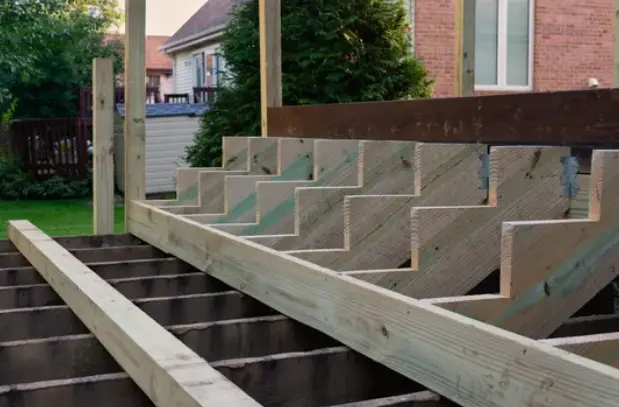
Tools and Materials
Before you begin building your wooden garden stairs, gather all the necessary tools and materials. Here’s a basic list to get you started:
Tools:
- Circular saw
- Tape measure
- Carpenter’s square
- Level
- Hammer
- Screwdriver
- Drill
- Shovel
- Wheelbarrow
- Safety gear (goggles, gloves, ear protection)
Materials:
- Wooden boards for stringers, treads, and risers
- Concrete mix
- Gravel
- Galvanized screws and nails
- Handrail and balusters (if desired)
- Wood stain or sealer
- Concrete footing forms (if needed)
Obtaining Permits
Depending on your location and the complexity of your project, you may need permits before construction begins. Check with your local building department to ensure you’re in compliance with zoning and construction regulations. Failure to obtain the necessary permits could result in costly fines or having to remove the stairs.
Site Preparation
Prepare the construction site by clearing any vegetation or debris. Mark the location where the stairs will be built and ensure it’s level.
If your garden terrain has a significant slope, you may need to excavate and create level footings for the stair stringers to rest on. These footings will provide stability and prevent settling over time.
Building Wooden Garden Stairs
1 Planning and Layout
Begin by planning the layout of your stairs. Determine the number of steps required to reach your desired height, ensuring each step’s rise and run adhere to safety standards.
Use a carpenter’s square and level to mark the stringer locations and the stairs rise and run on the wooden boards.
2 Excavation and Footings
If your garden terrain has a slope, dig holes for concrete footings at the base of each stringer location.
The depth and diameter of these holes will depend on your local building codes. Pour concrete into the holes and insert anchor bolts while the concrete is still wet. Once the concrete has cured, attach the stringers to the bolts using metal brackets.
3 Framing the Stairs
Cut the stringers according to your layout and attach them securely to the footings and the upper landing. Ensure they are level and evenly spaced. The stringers provide the structural support for your stairs.
4 Installing Treads and Risers
Attach the treads (the horizontal steps) and risers (the vertical pieces) to the stringers using screws or nails. Ensure they are level and securely fastened. You may choose to leave gaps between the treads to allow water to drain, reducing the risk of slipping.
5 Handrails and Balusters
For added safety and aesthetics, install handrails and balusters. Handrails provide support, especially on steep or high stairs, while balusters prevent falls. Securely attach them to the stringers and upper landing, ensuring they meet local safety codes.
6 Finishing Touches
Once your wooden garden stairs are complete, apply a wood stain or sealer to protect the wood from moisture and UV damage.
This will also enhance the stairs’ appearance and extend their lifespan. Regular maintenance, including cleaning and resealing, is essential to keep your stairs looking their best.
Maintenance and Care

Regular Cleaning
Keep your wooden garden stairs clean by sweeping away leaves, debris, and dirt regularly. Use a mild detergent and water to scrub off stains or mold. Avoid using harsh chemicals that can damage the wood.
Sealing and Staining
Reapply a wood stain or sealer every 1-2 years to protect the wood from moisture and UV rays. This will prevent fading, warping, and rotting, ensuring your stairs stay in excellent condition.
Repairing Damage
Inspect your stairs for any signs of damage, such as cracked treads or loose balusters. Repair or replace damaged components promptly to maintain safety and functionality.
Winter Care
In regions with harsh winters, take extra precautions to protect your wooden garden stairs. Use ice melt products that are safe for wood to prevent slip hazards. Consider covering the stairs with tarps or temporary shelters to shield them from snow and ice buildup.
Ideas and Inspiration
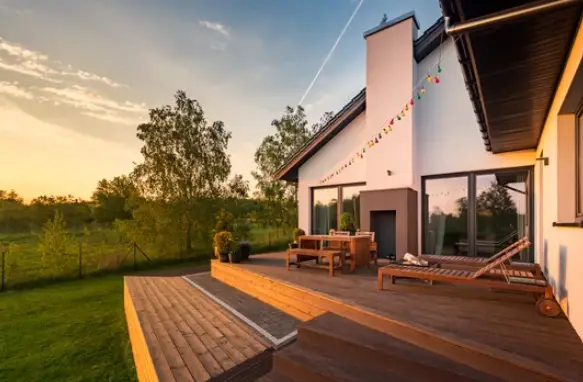
1 Classic Wooden Stairs
If you prefer a timeless look, opt for classic wooden stairs with straight lines and traditional materials.
2 Incorporating Planters
Add greenery to your stairs by incorporating built-in planters. These can be filled with colorful flowers or herbs, enhancing both the beauty and functionality of your garden stairs.
3 Multi-tiered Stairs
For gardens with multiple levels, multi-tiered stairs provide easy access and create visual interest. They can also be an opportunity to experiment with different wood types and designs.
4 Steps with Built-in Lighting
Illuminate your garden stairs with built-in lighting fixtures. This not only enhances safety but also creates a magical ambiance in the evening.
Warp Up
Wooden steps are a beautiful addition to any landscape because they combine functionality with elegance. You can enjoy lovely and useful garden stairs for many years to come by carefully considering the design, using high-quality materials, and following good construction and maintenance procedures.
The purchase of wooden garden steps is certain to be a lovely improvement to your outdoor haven, regardless of whether you’re an experienced DIY enthusiast or prefer to hire pros.
You can transform your garden into a peaceful retreat that is not only beautiful to look at but also simple to navigate with the correct tools and a little imagination.
The ideal way to add form and function to your garden is with wooden steps. Therefore, don your gardening gloves, roll up your sleeves, and

